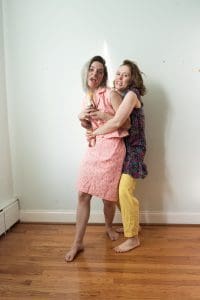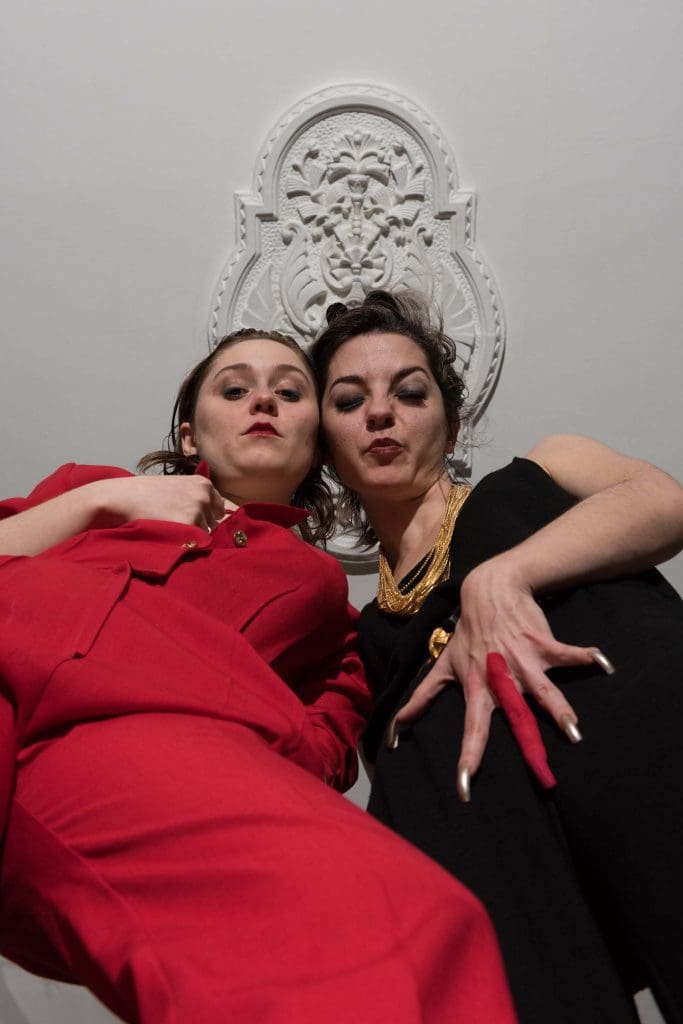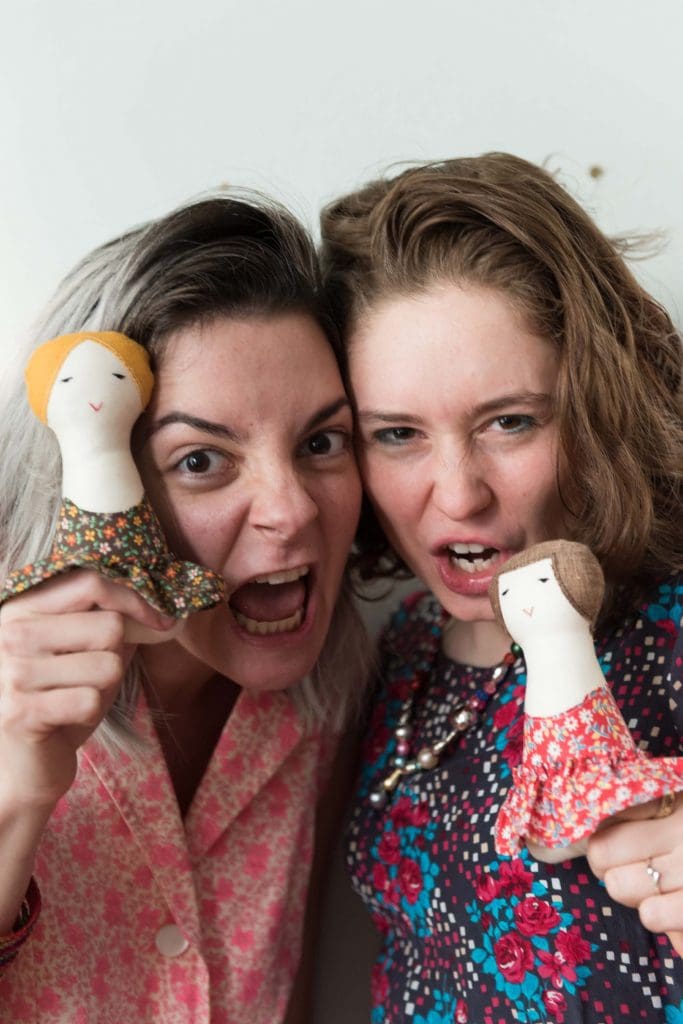The Loop of Integrity and Light-Up Sneakers : an Interview with Chelsea & Magda
“What would it be like to research yourself like an academic or test yourself like a scientist?”
Chelsea & Magda have been collaborating in Philadelphia for the past three years making dance theater duets. The Shame Symposium explores the link between shame and pleasure. Their research involves female friendships, public perception of aggression, the loop of integrity, Lisa Frank and light-up sneakers.
We caught up with Chelsea & Magda to find out more about their research process and work on The Shame Symposium.
FringeArts: How did you come up with the title The Shame Symposium?
Magda San Millan: We were in rehearsal sitting on the floor and talking about if we should stretch and start dancing or try to get some administrative work out of the way and we slipped into a title decision conversation. We were almost going to call it Recent Developments, Discoveries and Theories because our work is going away from the “show” format, with a unified theme, and towards a presentation of research. As an artist, what if I could present all of my interests and practices in one evening without trying to make it have a narrative or a cohesive-ish-ness? But admittedly much of our research has focused on shame and we want to give people the heads up—not everyone is interested in watching shame transformation.
Chelsea Murphy: I like the word “symposium” because it puts our work in an academic arena. It lets people know that we will be presenting research, experiments, and demonstrations. It will be a collection of performances, photographs, thoughts, and experiences around being a person with shame, which is every person. I agree with Magda, not everyone is interested in watching people explore their shame. So in that way I think this title is scary for us. It feels like it is really putting the vulnerable thing out there for everyone to see.
FA: Describe the shame/pleasure cake.
MSM: This term originated in an improvisational movement and text score that we developed at our Yard residency this past summer. The importance of the term now resides in the linking of shame and pleasure. We are not interested in shame that is action based or traumatic. Like: I was mean to this girl and I feel guilt about it and it made me think I was a bad person, etc. We are interested in shame that is linked to pleasure and reveals something about the personality that culture condemns. So, I often feel that I am an “aggressive woman.” I feel shame because people have shamed me about it. Telling me I’m too intense, etc. I feel shame because it implies that I want to hurt others, which I don’t want (to be clear). But I also feel pleasure in the experience of power, in the act of domination, in the explosiveness and playfulness. I don’t believe these qualities are inherently bad or harmful. And the question we pose to others is: Is there an aspect of your identity that causes you pleasure and shame? Let’s look at that. Let’s celebrate that. Because when we do we are going to see your full flawed and complex self onstage. And we are going to break the cycle of idealization to shame to idealization to shame . . .
CM: I don’t remember the moment that we made up Shame/Pleasure cake. It is a convenient food metaphor. I feel like people always look for food-to-art metaphors. In our research, the link between shame and pleasure around an aspect of my personality is clear. I believe shame and pleasure live on a spectrum with the object of the shame/pleasure in the middle. At The Yard we performed a layered improvisational movement score. The shame layers were: shame of genuine movement, shame of dancing to music, shame of improvised duet. Then we flip the cake upside down and reveal the pleasure layers: pleasure of large movement on my body, pleasure of feeling intense musicality, pleasure of being present with another person on stage. This specific shame/pleasure cake was crafted around our shame of what we perceive as “dance tropes” to avoid, but also how that tropes can sometimes feel wonderful.
FA: How will you incorporate others’ shame portraits into the show?
MSM: If we told you how we are going to make them we would be sharing our secret sauce. I’m not gonna share my secret sauce! We are currently taking more “Shame Portraits” which is literally a photograph in which a person inhabits the “less than ideal version of themselves.” We will include these images in the performance and talk about what they mean. We might project them huge, I liked how that felt when we did it at Scratch Night. We are also working with some performers to create “Performative Shame Portraits” in which they make a solo of that pleasure/shame identity aspect. So there will be some guest appearances/cameos of these. We’re making them collaboratively. That’s all I’m willing to say about it now.
CM: We’re working with a photographer named Jaime Alvarez on the shame portraits photographs. We have the participants answer a series of writing prompts. Asking them to list personality aspects about themselves that either they think are true, or others have said to them. Then they pick one that gives them Shame/Pleasure. We then work with the idea, feelings ,and images to make it a performative shame shoot. We often try to offer ourselves as tools in this process. We call ourselves “shame-doulas.” So if the person is trying to get in touch with their anger we can yell a lot, to make them feel more comfortable yelling. We like to do this because so often getting your picture taken feels absolutely terrible, and there is a whole other level of shame that comes with that. We don’t want the person to feel alone on the other side of the camera.
FA: Can you take us from the portrait to the stage?
MSM: The photos don’t lead to performance. They are separate things. The “Shame Portraits” are a subset of the tactics we are exploring for using shame as a tool to get whole, truthful versions of identity onstage.
CM: We are exploring a lot of our own shame and what feels good to perform. We do dances of shame and dances of pleasure. We do dances about our friendship and we have improvisational scores that create shame/pleasure situations right in front of the audience. We dance around with our childbodies because we want to get back to the purity of movement and pleasure. We make rants about things that we are angry about and that hurt us. We think of things that we have never seen women do on stage and we try to do them.
FA: Is there a framework to the show? For example, “it’s a cross between a slide lecture and a game show.”
MSM: Yes! Those are good guesses. They are some of our guesses too at this point. We will probably have slides. We will DEFINITELY lecture. This is the show in which we are letting ourselves talk as much as we want. We have fantasies of a game show called “Guess Her Shame!” which is totally bizarre and nerve racking. I don’t know if that will make it in. We don’t want to freak anyone out. Shame is a delicate flower. You have to be gentle with her. And we have to protect her.
CM: The show is a bit like Russian nesting dolls. Shame/pleasure cakes inside of shame/pleasure cakes inside of other surprise shame/pleasure cakes. Part of it will be “formal” research presentation. Improvisational experiments in front of the audience with immediate reflection of experience. The Shame Symposium is definitely female.
The Shame Symposium
Chelsea & Magda
June 9-12
FringeArts Theater
140 North Columbus Boulevard (at Race)
Philadelphia, PA 19106




